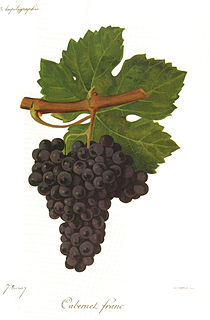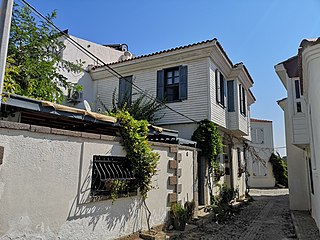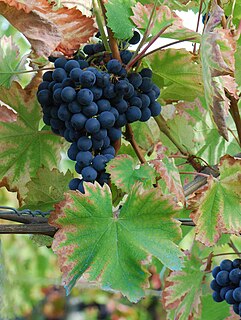Related Research Articles

Merlot is a dark blue–colored wine grape variety, that is used as both a blending grape and for varietal wines. The name Merlot is thought to be a diminutive of merle, the French name for the blackbird, probably a reference to the color of the grape. Its softness and "fleshiness", combined with its earlier ripening, makes Merlot a popular grape for blending with the sterner, later-ripening Cabernet Sauvignon, which tends to be higher in tannin.

Cabernet Sauvignon is one of the world's most widely recognized red wine grape varieties. It is grown in nearly every major wine producing country among a diverse spectrum of climates from Australia Okanagan Valley to Lebanon's Beqaa Valley. Cabernet Sauvignon became internationally recognized through its prominence in Bordeaux wines where it is often blended with Merlot and Cabernet Franc. From France and Spain, the grape spread across Europe and to the New World where it found new homes in places like California's Santa Cruz Mountains, Paso Robles, Napa Valley, New Zealand's Hawkes Bay, South Africa's Stellenbosch region, Australia's Margaret River, McLaren Vale and Coonawarra regions, and Chile's Maipo Valley and Colchagua. For most of the 20th century, it was the world's most widely planted premium red wine grape until it was surpassed by Merlot in the 1990s. However, by 2015, Cabernet Sauvignon had once again become the most widely planted wine grape, with a total of 341,000 hectares (3,410 km2) under vine worldwide.

Syrah, also known as Shiraz, is a dark-skinned grape variety grown throughout the world and used primarily to produce red wine. In 1999, Syrah was found to be the offspring of two obscure grapes from southeastern France, Dureza and Mondeuse Blanche. Syrah should not be confused with Petite Sirah, a cross of Syrah with Peloursin dating from 1880.
Imbros and Tenedos, also known by their official names since 1970 of Gökçeada and Bozcaada, are two neighboring North Aegean islands which belong to Turkey. They form the districts of Gökçeada and Bozcaada, in Çanakkale province.

Cabernet Franc is one of the major black grape varieties worldwide. It is principally grown for blending with Cabernet Sauvignon and Merlot in the Bordeaux style, but can also be vinified alone, as in the Loire's Chinon. In addition to being used in blends and produced as a varietal in Canada and the United States, it is sometimes made into ice wine in those regions.

Carignan is a red grape variety of Spanish origin that is more commonly found in French wine but is widely planted throughout the western Mediterranean and around the globe. Along with Aramon, it was considered one of the main grapes responsible for France's wine lake and was a substantial producer in jug wine production in California's Central Valley but in recent years, it has been reborn as a flagship wine for many cellars in the south of France as well as in Catalonia.

Tenedos, or Bozcaada in Turkish, is an island of Turkey in the northeastern part of the Aegean Sea. Administratively, the island constitutes the Bozcaada district of Çanakkale province. With an area of 39.9 km2 (15 sq mi) it is the third largest Turkish island after Imbros (Gökçeada) and Marmara. In 2018, the district had a population of 3023. The main industries are tourism, wine production and fishing. The island has been famous for its grapes, wines and red poppies for centuries. It is a former bishopric and present Latin Catholic titular see.

Grenache or Garnacha is one of the most widely planted red wine grape varieties in the world. It ripens late, so it needs hot, dry conditions such as those found in Spain, where the grape most likely originated. It is also grown in the Italian island of Sardinia, the south of France, Australia, and California's Monterey AVA and San Joaquin Valley.

Aligoté is a white grape used to make dry white wines, especially in the Burgundy region of France where it was first recorded in the 18th century. Since it is tolerant to cold, this variety is also cultivated in Eastern European countries. In 2004, it was the 22nd most planted vine variety in the world at 45,000 hectares.

Mourvèdre is a red wine grape variety grown in many regions around the world including the Rhône and Provence regions of France, the Valencia and Jumilla denominaciones de origen of Spain, as well as the Balearic Islands, California and Washington and the Australian regions of South Australia and New South Wales, as well as South Africa. In addition to making red varietal wines, Mourvèdre is a prominent component in "GSM" blends. The variety is also used to make rosé and port-style fortified wines.

The Thracian Sea is the northernmost part of the Aegean Sea. It is bounded by Macedonia and Thrace as well as northwestern Turkey. The entire area of the sea lies north of the 40th parallel. Its length from east to west is from 23°E to about 25.8°E, or from the Strymonian Gulf east to the northernmost part of the Gallipoli peninsula and the width from north to south is about 40.25°N to 41°N, or from the Dardanelles north to the boundary between the Xanthi and the Rhodope regional units. Islands includes Thasos and Samothrace in Greece and Gökçeada and Bozcaada in Turkey. The bays and gulfs includes the Ierissian Gulf to the southwest, the Strymonian Gulf where the Strymon River empties, the Kavala Gulf and the Saros Gulf in Turkey. Rivers emptying into this portion of the gulf include the Nestos and the Evros/Meriç. The famous thermal springs are Loutra Eleftheron in Kavala.

Grenache blanc is a variety of white wine grape that is related to the red grape Grenache. It is mostly found in Rhône wine blends and in northeast Spain. Its wines are characterized by high alcohol and low acidity, with citrus and or herbaceous notes. Its vigor can lead to overproduction and flabbiness. However, if yields are controlled, it can contribute flavor and length to blends, particularly with Roussanne. Since the 1980s, it has been the fifth most widely planted white wine grape in France after Ugni blanc, Chardonnay, Semillon and Sauvignon blanc.
Limnio (LIM-nee-oh) is a red Greek wine grape variety that is indigenous to the Greek island of Lemnos. The grape has had a long history of wine production that may extend back to Ancient Greece with wine historians widely believing it was the grape variety, Lemnia, that was described by Aristotle as producing the famous red Lemnian wine. According to wine expert Oz Clarke, Limnio is "One of Greece's most important red vines."
Papazkarası, also Papaskara, is a Turkish grape variety and a Turkish wine grown in the Marmara and Central Anatolia regions of Turkey. This variety was used to make a red wine blend with Cinsaut. The wine has an alcohol ratio between 11 and 13%, and an acidity range of 6 to 8 grams/liter. Papaskarası is also registered in Greece as Kara Papas. It is a very old Thracian varietal and probably the best winegrape cultivar in Turkey. Kirklareli Uskup region is known as the best terroir for Papaskarası. Uskup terroir is based on Strandja decomposed granites, which gives very low yields and small bunches of grapes. In the fertile lowlands, the bunches can be much heavier, at around 500 grams per bunch. Verasion time occurs between mid August and late August at Uskup. The wine can be blended with Cabernet Sauvignon and Merlot. Maturity period is very late between mid October and mid November. Total Growing degree-day required is around 1.890 GDD. Papaskarası gives very high acidity to wines. In very ripe years, it can reach to 25 brix levels in the lowland Thracian vineyards of Uzunköprü.

Olmo grapes are wine and table grape varieties produced by University of California, Davis viticulturist Dr. Harold Olmo. Over the course of his nearly 50-year career, Dr. Olmo bred a wide variety of both grapes by means of both crossing varieties from the same species or creating hybrid grapes from cultivars of different Vitis species.

Bozcaada Castle is a castle in the Turkish island of Bozcaada.
Çavuş, is a white prolific Turkish grape variety which is grown especially in Bozcaada-Çanakkale, Marmara Region and Central Anatolia Region.
Karasakız is a Turkish red wine grape variety grown in the Thrace region. It is known as Kuntra in Bozcaada. It has been used in cognac production for a long time. Recently, it is used as a wine grape variety by making both varietal and blending with other grape varieties. In Bozcaada, it is often blended with Karalahna grape variety.
References
- ↑ "2012 Corvus Vineyards Rarum (Kuntra-Karalahna Blend), Turkey, Bozcaada - CellarTracker". www.cellartracker.com. Retrieved 2021-01-11.
- ↑ "Karalahna: Bozcaada'nın gizemli üzümü ile özel şarabı ve adanın sırları". Keyifnotları (in Turkish). 2011-05-08. Retrieved 2021-05-17.